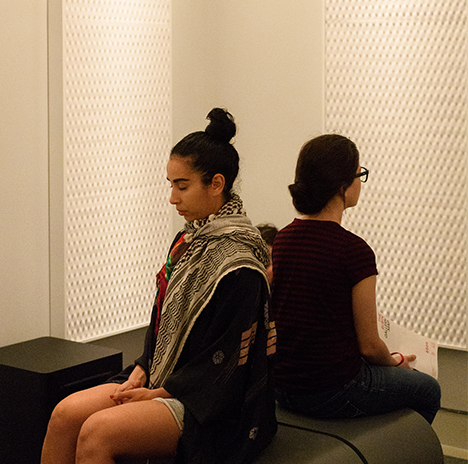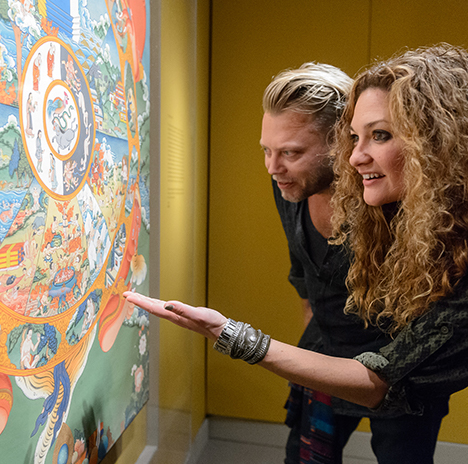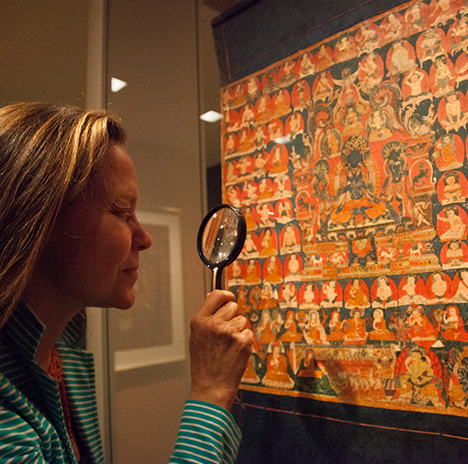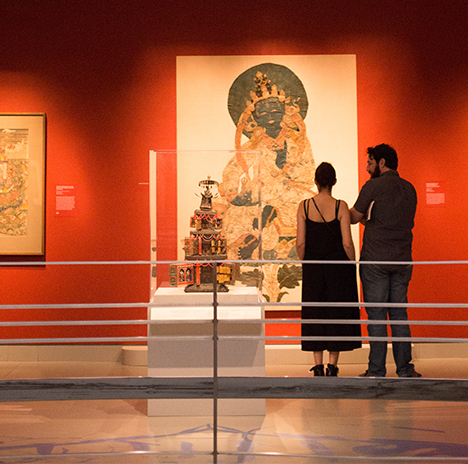
Mindfulness—the practice of focusing on the present moment while calmly observing your thoughts and feelings—can reduce stress, increase selÂÂf-awareness, and deepen empathy with others. Here at the Rubin, we offer meditation sessions, workshops, and talks exploring many facets of the subject. And one of the best places to experience mindfulness is right in our galleries, while you’re looking at art. Of course, it helps most pieces in our collection are from Buddhist and Hindu traditions that emphasize meditation and mindfulness.
That said, you can practice mindfulness while viewing any art, at any museum, not just at the Rubin, because art and mindfulness have a lot in common. Much like mindfulness, art invites you to step into the present moment, unplug from your everyday concerns, and focus deeply on the object in front of you. Engaging mindfully with art can help you experience and appreciate it more fully. It might also help you gain some of the broader benefits of mindfulness. Here’s how:
Step 1: Let distractions fall away

First, put your phone away. The selfies, feeds, and messages can wait. Now it’s time to go deep with an artwork. Next, let your everyday thoughts drop away as you engage with the art. This can be hard to do, as anyone who has meditated knows. That’s why in meditation practice people often focus on their breath, so they have a substitute for the endless train of thoughts rattling through their brain. The same general approach works with art as meditation: Do you best to focus on a single piece of art and nothing else.
Step 2: Observe your reaction to the artwork

What is your first impression? Does the artwork make you feel anything? Some people experience a feeling of serenity when they gaze upon a Buddha. Art can stir up plenty of other feelings too. Maybe the mysterious expression on the face of a Renaissance portrait at the Met makes you feel curious or amused. The rhythmic splotches on a giant Jackson Pollock canvas at MoMA could arouse emotions you can’t quite name. Or you might feel no discernable emotion at all; that too is an emotional reaction. Whatever your initial reaction might be, notice it without judging it.
Step 3: Take in the details

Do any details of the art catch your eye? It can be something as simple as the graceful curve of a deity’s arm in a sculpture at the Rubin, or a surprising combination of colors in a painting. Why does this particular detail intrigue you? It might reveal some deeper meaning about the artwork, or it might simply delight your eye. There is no wrong answer. Let your curiosity be your guide as your gaze naturally roves across the art.
Step 4: Repeat with another artwork—and take your time

Try to take a deep dive like this with every artwork you see. On national Slow Art Day, we encourage people to spend 10 whole minutes looking at a single piece of art. This might feel like too much, and that’s okay. The main point is to slow down and focus. If you need help focusing, try an audio guide, like this audio tour of the Rubin’s Masterworks exhibit, which gives you some historical background on each piece.
As you take a slow ride through the museum, you might find that the chattering, distracting thoughts you needed to deliberately push away at the beginning of your visit have now naturally receded. Has anything else in your mental state shifted? You might feel more relaxed, more expansive, more”¦something.
If you want to bring more mindfulness home with you, check out the Rubin’s Mindfulness Meditation podcast. Each episode features a talk by an expert meditation guide inspired by an artwork from our collection.
Support of Masterworks of Himalayan Art has been provided by contributors to the 2018 Exhibitions Fund.
Mindfulness Meditation is supported in part by the Hemera Foundation with thanks to our presenting partners Sharon Salzberg, the Interdependence Project, and Parabola Magazine.

